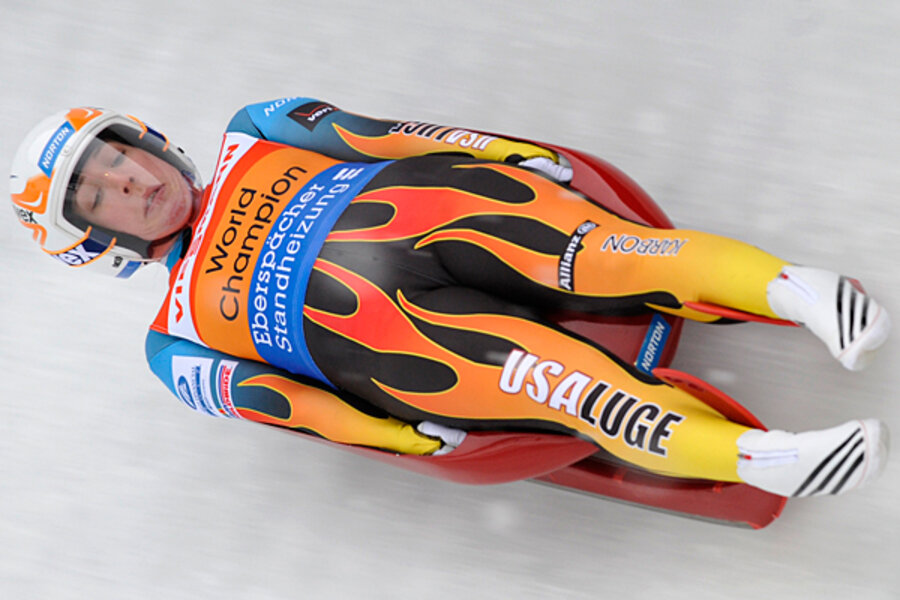How US luger Erin Hamlin cracked the German dynasty
Loading...
| Whistler, British Columbia
Germany has won every Olympic medal in women’s luge in this century, and seven of the past 10 golds. But with two runs to go in the women’s Olympic luge event, the dynasty is showing signs of cracking.
American Erin Hamlin – a no-frills girl from upstate New York who “shocked” the luge queens by ending their 99-win streak at World Championships last year – had been favored to repeat the feat here at the 2010 Games.
Now, sitting in 15th going into the final day of racing today, Hamlin's a long shot for a medal. But she can triumph in the fact that she showed it was possible to beat the Germans. That is good for a sport that's become a little too predictable, say others in the luge community. If she can bring home hardware, all the better.
“[If she medals], that’ll be huge for the whole sport because it’s been so German-based,” says Ashley Walden, a 2002 Olympian and member of the US national team. “It’s boring.”
Even the Germans recognize that point, Hamlin has said, explaining that some had congratulated her on beating their teammates.
“Granted, their team didn't win, but at the same time they understand this is going to be great for the sport and brings a new perspective," Hamlin said, according to Voice of America. "The German women have had that streak for so long, but not having them up there, not having to hear the German [national] anthem again, was awesome."
A literal change of course
Both Hamlin and her three German rivals were thrown off by the decision Saturday to shorten the women’s race after Nodar Kumaritashvili’s fatal accident Friday heightened concerns about the track's safety. A nod to those concerns and the emotional difficulty of the situation, the decision has angered many of the top racers, who enjoyed the challenge of a track that has been billed the fastest in the world. After having prepared for ballistic turns that pull more Gs than an astronaut would feel in a space-shuttle launch, they’re now being tested on a course that rewards precision more than brute strength and speed.
“We trained the whole summer and we are strong and fast, and now the fastest starters are slow,” said Natalie Geisenberger, calling the new course children’s play. “It’s not a ladies' start, it’s a kinder-start.”
“The way the ramp shoots you into the curve, it feels like you’re trying to make a 90-degree turn with your sled … and that’s virtually impossible,” added Hamlin.
Meaghan Simister, part of a Canadian team that had closely guarded their home-track advantage, expressed similar frustrations. In particular, she and other racers criticized the very short straightaway at the outset, which doesn’t allow the strong starters the usual advantage they get by “paddling” down the initial ramp with spiked gloves.
“It’s a horrible start, very awkward,” said Simister, one of the fastest starters in the world, according to Canwest News Service. “This is totally unlike any other track on the World Cup circuit.”
“It’s like running into a brick wall,” agreed teammate Alex Gough, who noted that 13-year-olds race from that start. “There is no way else to describe it.”
In the first two runs on Monday, the Germans managed fairly well on the revised course, which starts lower down on the track. Going into the final two runs on Tuesday, they were sitting in first, third, and fifth position, with an Austrian and a Latvian mixed in. Hamlin had been eighth after the first run but fell to 15th after her second heat. The racer with the fastest cumulative time in all four heats wins.
Germany's lugeing roots run deep
While Hamlin, the reigning world champion, scrapes together the money to make payments on her new Volkswagen, Germans have a reported 15 national-team coaches and the support of a system that has won 29 of the 39 world championships contested since the inaugural event in 1955. Lugeing great George Hackl was named athlete of the year, putting him on par with Michael Schumacher.
A German has presided over the International Luge Federation since 1994, and its press officer and executive director are also German.
The country has four of the world’s 14 refrigerated tracks, university professors whose sole job is to figure out how to make sleds go faster, and a huge feeder system that has 1,000 kids under age 12 participating in Bavaria alone.
“There’s such a depth of athletes, we have the luxury to draw from the strongest, tallest,” says Wolfgang Staudinger, a German coach whom Canada wooed under its Own The Podium program. “I didn’t have to coach; I selected.”
Much of the Germans’ success stems from a well-funded system created under the East Germans. When Staudinger, who took bronze to two East Germans at the 1988 Olympics, found out the resources they had at their disposal, he was shocked.
“I thought, ‘Holy smokes, if I had [had that at my disposal], I would have done so much better.’ ”
Canadians lose home-track advantage
Now, Staudinger knows it all and he’s helped the Canadians transform themselves from participants to Olympic contenders. But a key part of their strategy – the home track advantage – was stripped away when the course was revised in the wake of Friday’s fatal accident.
But while the Canadians were clearly frustrated, team veteran Regan Lauscher tried to stay positive.
“Yes, it’s unfortunate for the Canadian team because we’ve lost that home-field advantage,” said Lauscher. “But it’s the people who can adapt to anything that should be the champions.”
[Editor's note: The original story incorrectly stated Hamlin's position after the second heat.]
_______________
Keep up to date with Christa's tweets throughout the Games. Christa trained full time for the Olympics from 1997-2002 in cross-country skiing.






